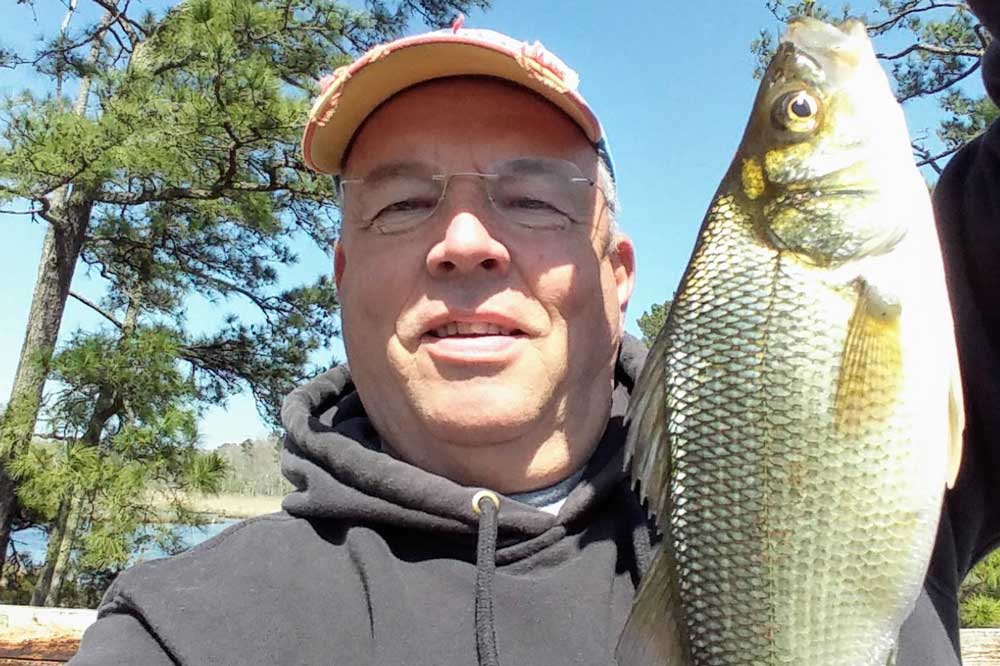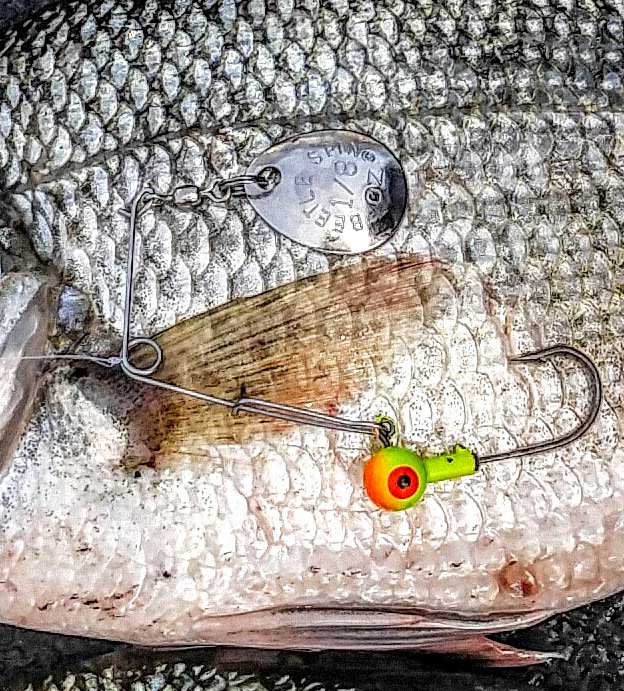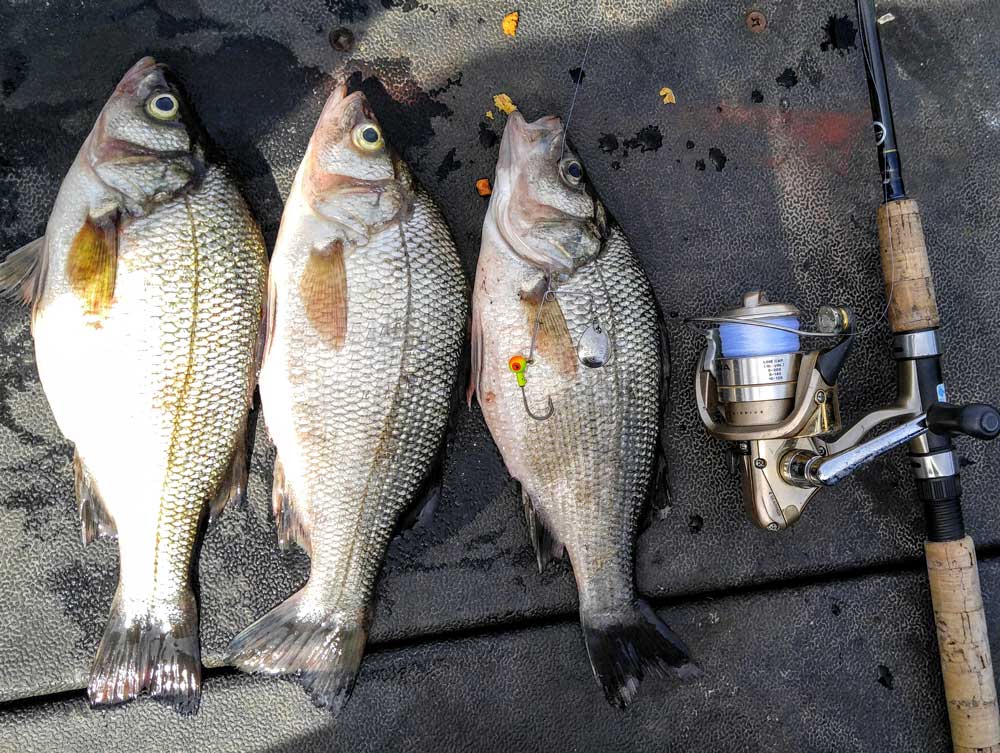Fishing for white perch has always been a part of my life. As a youngster growing up on Bear Creek, fishing and waterborne activities took up a large chunk of my life. Eel grass was so thick around our pier in the swimming area that it was pulled out by the handful so it didn’t wrap around your legs. Those handfuls of grass were also perfect for starting a “grass fight” with buddies. Crabbing was outstanding, providing all we could steam using just a few hand lines tied off around the pier, although it could be difficult at times to pull a big ‘ol jimmy up through the grass to be netted. Peelers and soft crabs were there for the asking, by slowly wading through the grass near shoreline with a net. Rockfish, spot, yellow perch, white perch, and an occasional croaker with catfish and eels mixed in, were caught right off the pier.

Once I was old enough to operate the boat, Seven foot knoll, Craig Hill light, Belvedere shoals and Man O War Shoal became routine stomping grounds. The same species caught off the pier were caught at those locations, with the exception of yellow perch. Depending on the salinity levels, some years sea trout (often plentiful on Bodkins Point shoal) along with bluefish and a rare flounder made their way to the north side of the Bay Bridge and joined the typical list of species caught. But alas, today not a single blade of eel grass can be found in the creek. Gone with it are most of the yellow perch, spot, and croaker. An occasional rockfish can be caught and crabs still tug on hand lines, but not in numbers like years ago. My educated guess is industrial pollution and urban runoff ruined the creek’s fishery by killing off the grass which we took for granted in childhood. But surprisingly, the creek still holds an abundance of white perch. Through low oxygen levels, septic spills, and fish kills caused by who-knows-what in the creek, perch are the one species that always flourished and can still be counted on after all these years to provide fun on a rod and delicious on the dinner plate.
White perch are found enjoying Chesapeake Bay fishing, along with the coastal tributaries, and also in many lakes and reservoirs. They are one of the most abundant fish in the Mid-Atlantic region, and live their entire lives without migrating away from it. Their size is never going to test an angler’s strength, but by being so plentiful, you may in fact get tired from catching this small feisty fighter. The Chesapeake division record is held by Sid Stollings, who caught a monster 2.3-pounder back in 1979 in Dundee Creek. The Atlantic division record is owned by Ryan Timmons, with a 1.65-pound fish caught in July of 2016 in Ayers Creek – which is where you will find me when I’m not chasing flounder in the back bays this spring. The non-tidal record has George Venker’s name next to a 1.9-pound white caught in Loch Raven Reservoir just a couple years ago.
The white perch spring spawn follows the yellow perch. From below Conowingo dam (Lapidum, just across the Susquehanna from Port Deposit, is good location to wet a line) down to the mouth of the Chesapeake, white perch travel up into tributaries and spawn in fresh waters when water temperatures are between 50 and 60 degrees. The spawn is going to vary in time from the top of the Chesapeake to lower Bay and the ocean side. But it’s almost a sure bet that anglers can shake off winter cabin fever with bent rods by keeping tabs on the nearby creek’s water temperatures.
White perch are not picky eaters, but like all species, do not feed 24/7. Their preference is moving water occurring a couple hours before or after high and low tides. High tide will draw fish right up to the shoreline along bulkheads or grass-lined areas. During low tides you’ll typically find them sticking to the edge of drop-offs. Bloodworms, clam snots, peeler crab, soft crab, earthworms – the list goes on and on of what this species will swallow. But hands down, over the decades I’ve found minnows the best choice for early season. White perch may look a bit like stripers and have an appetite that’s similar, but they do not share a striper’s big mouth. Offerings kept on the smaller side are a good choice; stay away from those monster bull minnows you search for in a bucket that the flounder love to devour.

Artificial lures count for a fair share of catches as well. A Mepps #2 spinners, shad darts, or small bucktail all are good choices, but there is one bait that has never let me down, no matter where I cast a line for white perch. That is a combination of a spinner blade/jig head with a live minnow on the hook. If there are hungry perch around, this bait is a winner. Shop around, purchase a few plain Beetle-spin blades (#1 or #2 can be found on Ebay for under a buck a piece in bulk), pick up a color assortment of 1/8th ounce jig heads (yellow and white are my favorites), then get some minnows and you’re in business. Hook the minnow on jig by coming up through the bottom lip and out the top so the minnow swims natural when being retrieved. Cast out, and work the rig close to shoreline or near any type of structure observed protruding from the water. If there’s no joy, then cast to deeper water and allow the spinner and minnow to fall before retrieving; the fish may be schooled up near bottom. Vary retrieval speed and casting areas until the fish are located.
A light or ultra-light spinner outfit spooled with four-pound mono or 10-pound braided line allows longs cast with the lightweight presentation, while being capable of whipping any perch encountered. After the spawn, this rig still works in shallower water throughout the summer. However, if you’re fishing in the main stem of the Bay or deep holes in rivers, a typical bottom rig is all that’s necessary for catching the ready and reliable white perch. Recently anglers have also taken to using Chesapeake Sabiki rigs while fishing for perch in deep water. Take a look at the fast action it results in, and you'll see why!

FishTalk’s Coastal Correspondent John Unkart is author of “Offshore Pursuit” and “Saltwater Tails, available on Amazon.”